PackML 从会到不会——模式(2)
最近又重新在想起标准化的东西。在工控行业要说设备标准化哪个最成功的——当属 PackML。所以开此坑,用于记录学习(啃标准文档 ANSI/ISA 88.00.02)的过程.
模式(Modes)
The ISA88.00.01 standard provides a set of modes for equipment entities and procedural elements. This report establishes modes for automated machines that are considered different than the ISA88.00.01 procedural modes (automatic, semi-automatic, and manual). The ISA88.00.01 Procedural modes describe the way procedures operate. Procedural modes are not common in Automated Machinery. They are provided for in this report by noting they may exist, but are not considered in the scope of this work and are not included in the tag table. For automated machines, the example in this report establishes unit/machine modes in order to allow a machine designer to adjust the set of states, state commands and state transitions a machine may follow given different operating circumstances. The set of defined unit/machine control modes is shown in Figure 4 and described below. The 2013 revision to this document changed Producing mode to Production mode.
ISA88.00.01 标准为设备实体和程序元素提供了一组模式。 该报告为被认为不同于 ISA88.00.01 程序模式(自动、半自动和手动)的自动化机器建立了模式。 ISA88.00.01 程序模式描述了程序运行的方式。 程序模式在自动化机械中并不常见。 在本报告中提供了它们,指出它们可能存在,但不在本工作范围内考虑,也不包括在标签表中。 对于自动化机器,本报告中的示例建立了单元/机器模式,以允许机器设计人员调整机器在不同操作环境下可能遵循的状态集、状态命令和状态转换。 一组定义的单元/机器控制模式如图 4 所示,并在下面进行了描述。 本文档的 2013 年修订版将生产模式更改为生产模式。
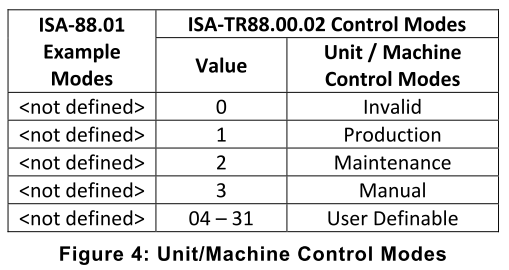
控制模式(Unit / Machine Control Modes)
A Unit/Machine Control Mode is an ordered subset of states, state commands, and state transitions that determines the strategy for carrying out a unit/machine’s process.
单元/机器控制模式是状态、状态命令和状态转换的有序子集,它决定了执行单元/机器过程的策略。
Typical Unit Control Modes are Production, Maintenance, Manual, Clean in Place, Run Out, Semi-Auto, Dry Cycle, etc. The distinguishing elements between these Unit Control Modes are the selected subset of states, state commands, and state transitions.
典型的单元控制模式是生产、维护、手动、原位清洁、运行、半自动、干循环等。这些单元控制模式之间的区别元素是选定的状态子集、状态命令和状态转换。
The ordered procedures within the states will be unique for the Unit Control Mode that the state resides in. For example, in a “Production” Unit Control Mode the definition of “execute” in a filling machine will mean it is “producing” product. In the “Manual” Unit Control Mode the definition of the “executing” state may be jogging or indexing. The “Execute” State defines the functional operation of the Unit Control Mode. States of identical names may have different functions in different Unit Control Modes
状态内的有序程序对于状态所在的单元控制模式将是唯一的。例如,在“生产”单元控制模式中,灌装机中“执行”的定义将意味着它是“生产”产品。 在“手动”单元控制模式下,“执行”状态的定义可能是点动或分度。 “执行”状态定义了单元控制模式的功能操作。相同名称的状态在不同的单元控制模式下可能具有不同的功能。
Production Mode - This represents the mode which is utilized for routine production. The machine executes relevant logic in response to commands which are either entered directly by the operator or issued by another supervisory system.
生产模式 - 这表示用于日常生产的模式。机器根据操作员直接输入或其他监控系统发出的命令执行相关逻辑。
Maintenance Mode - This mode may allow suitably authorized personnel the ability to run an individual machine independent of other machines in a production line. This mode would typically be used for fault finding, machine trials or testing operational improvements. This mode would also allow the speed of the machine to be adjusted (where this feature is available).
维护模式——这种模式可以允许适当授权的人员独立于生产线中的其他机器运行单个机器。这种模式通常用于故障查找、机器试验或测试操作改进。此模式还允许调整机器的速度(在此功能可用的情况下)。
Manual Mode - This provides direct control of individual machine modules. This feature is available depending upon the mechanical constraints of the mechanisms being exercised. This feature may be used for the commissioning of individual drives, verifying the operation of synchronized drives, testing the drive as a result of modifying parameters etc.
手动模式 - 这提供了对单个机器模块的直接控制。此功能是否可用取决于正在使用的机制的机械约束。此功能可用于单个驱动器的调试、验证同步驱动器的运行、测试驱动器作为修改参数的结果等。
控制模式管理(Unit / Machine Control Mode Management)
Automated machinery has Unit Control Modes other than “Production”, as noted earlier. Each unit control mode has its own state model. In order to manage the change from one mode to the next, a method of mode management must be defined. The mode management method determines how, and in what state a machine may change Unit Control Modes; i.e. the mode management method includes interlocks that prevent the machine changing Unit Control Modes when in inappropriate states.
如前所述,自动化机械具有除“生产”以外的单元控制模式。每个单元控制模式都有自己的状态模型。为了管理从一种模式到另一种模式的变化,必须定义一种模式管理方法。模式管理方法决定了机器如何以及在何种状态下可以改变单元控制模式;即模式管理方法包括互锁,以防止机器在不适当的状态下更改单元控制模式。
Unit control mode management enables the machine designer to manage unit control mode transitions. Specification on transitions between unit control modes is left to the user, but typical transition points are at wait states. The specification of the unit control mode manager is such that no state or control functions are carried out in this upper level routine. The intent of the mode manager is to logically supervise when a change in mode can be done, command a mode change, and report status of the change request. All considerations of a mode manager must be consistent with prevailing safe practices and standards.
单元控制模式管理使机器设计人员能够管理单元控制模式转换。单元控制模式之间的转换规范由用户决定,但典型的转换点处于等待状态。单元控制模式管理器的规范是在这个上层程序中不执行任何状态或控制功能。模式管理器的目的是在逻辑上监督何时可以完成模式更改、命令模式更改并报告更改请求的状态。模式管理者的所有考虑都必须符合现行的安全实践和标准。
Transitions between Unit Control Modes can occur at only pre-programmed states:
As a result of a local or remote operator command.
As a result of a remote request from another automated unit.
As a result of a State change. This is generated by change of state of one or a number of machine conditions, either directly from I/O or completion of a logic method. For example, if a filling machine has completed its production run in “PRODUCTION” mode of a given number of cases it may change to the “CLEANING” mode to begin a clean cycle.
When a Unit Control Mode change takes place, a Machine State change is NOT allowed to occur at the same time. Mode Transitions must take place in a state that is common to both modes. This is necessary to avoid unintended machine sequences from taking place.
单元控制模式之间的转换只能发生在预编程状态:
作为本地或远程操作员命令的结果。
由于来自另一个自动化单元的远程请求。
由于状态变化。 这是通过直接从 I/O 或逻辑方法的完成改变一个或多个机器条件的状态而产生的。例如,如果灌装机在给定数量的情况下以“生产”模式完成其生产运行,它可能会更改为“清洁”模式以开始清洁循环。
发生单元控制模式更改时,不允许同时发生机器状态更改。模式转换必须在两种模式共同的状态下发生。这对于避免发生意外的机器序列是必要的。
控制模式例子(Common Unit / Machine Mode Examples)
生产模式(Production Mode)
The Base State model above can be used to define a Production Mode that is used in order to deliver control of routine processing and production. It is recognized that machines also require maintenance, calibration and setting up. To address this requirement two example modes of operation are shown below: Maintenance and Manual. Because there can be any number of possible modes for an Automated Machine a User Mode example is also shown. The User Mode example is based on the Weihenstephan PDA (Production Data Acquisition) standard.
上面的基本状态模型可用于定义生产模式,用于提供对常规加工和生产的控制。众所周知,机器也需要维护、校准和设置。为了满足这一要求,下面显示了两种示例操作模式:维护和手动。因为自动化机器可以有任意数量的可能模式,所以还显示了用户模式示例。用户模式示例基于 Weihenstephan PDA(生产数据采集)标准。
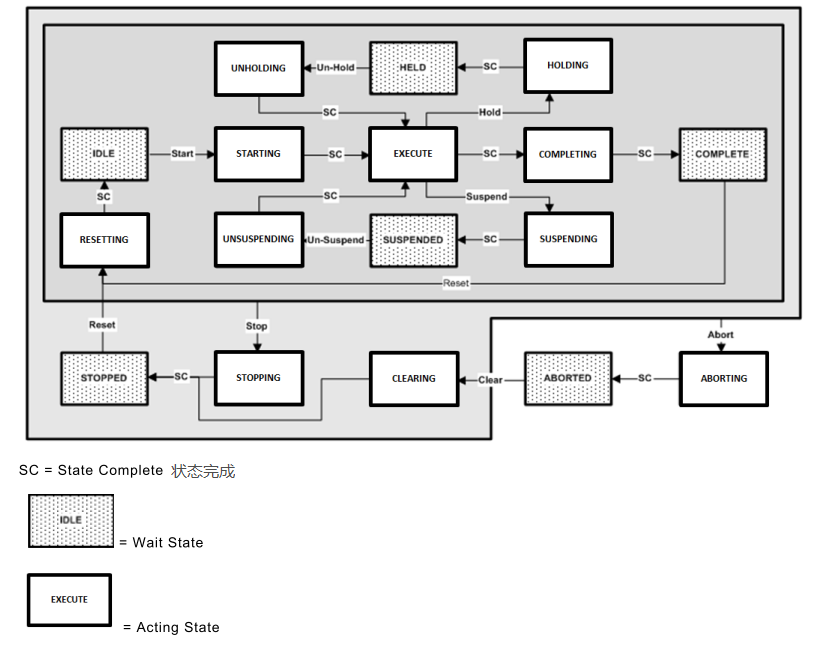
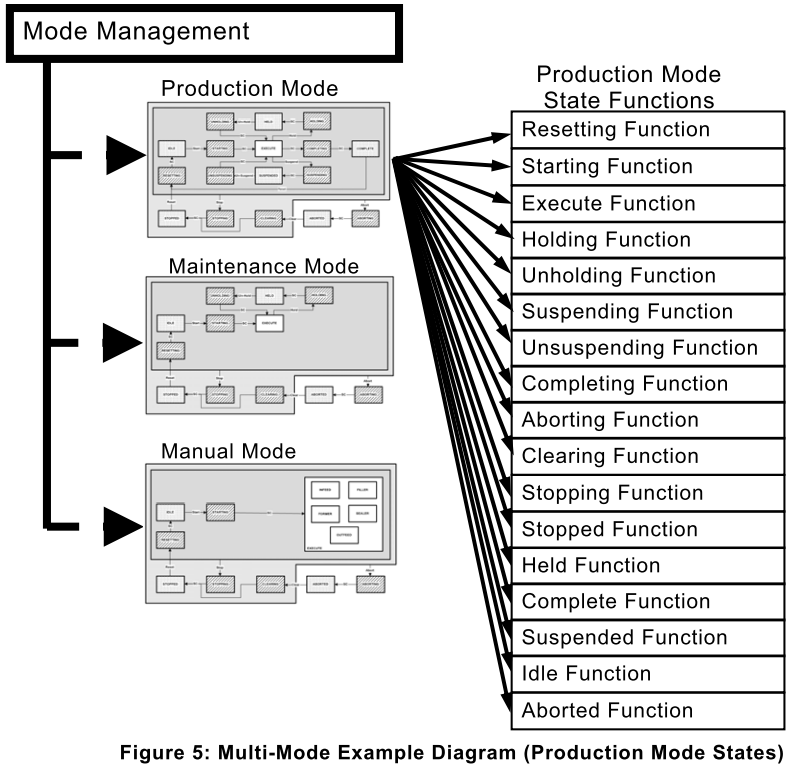
维护模式(Maintenance Mode)
Maintenance Mode allows suitably authorized personnel the ability to run an individual machine independent of other machines in a production line. This would typically be used for fault finding, machine trials or testing operational improvements. It is expected that, because the machine will generally operate in its usual manner, it will need to undergo some or all of its routine starting up procedures. Maintenance mode will follow a recognized unit state model.
维护模式允许经过适当授权的人员能够独立于生产线中的其他机器运行单独的机器。这通常用于故障查找、机器试验或测试操作改进。预计,由于机器通常会以其通常的方式运行,因此需要进行部分或全部例行启动程序。维护模式将遵循公认的单元状态模型。
By way of example, one possible Maintenance Mode state model is shown in Figure 6 below. It is recognized that individual machine manufacturers may have good reason to develop other versions of maintenance mode state models. Typically modes, such as Maintenance Mode are developed as containing a subset of the unit states in the Base State Model. The unit state names remain consistent but the function of the states has been modified to be consistent with the mode function.
例如,下面的图 6 显示了一种可能的维护模式状态模型。人们认识到,个别机器制造商可能有充分的理由开发其他版本的维护模式状态模型。通常模式(例如维护模式)被开发为包含基本状态模型中单元状态的子集。单元状态名称保持一致,但状态功能已修改为与模式功能一致。
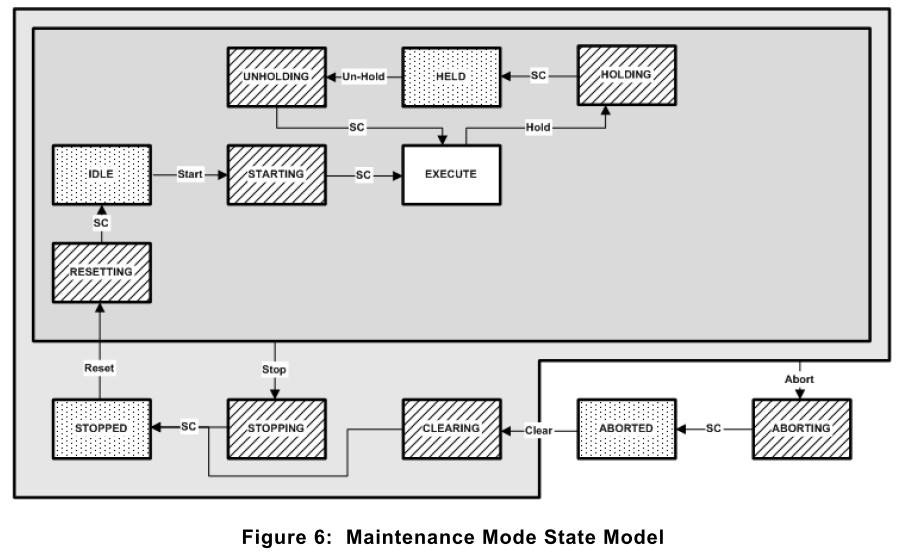
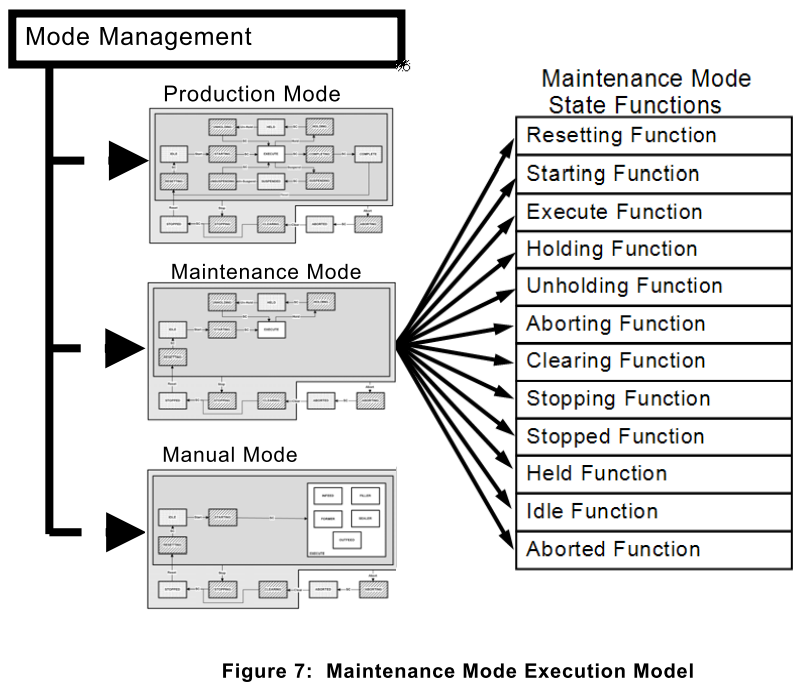
手动模式(Manual Mode)
Manual Mode provides suitably authorized personnel the ability to operate individual subordinate equipment controls (such as drive logic) within the machine under manual pushbutton control. Such controls in this mode may be on a "hold-to-run" basis such that removal of the run signal will cause the drive to be stopped. The ability to perform specific functions will be dependent upon mechanical constraints and interlocks. Manual mode will be of particular use for setting up the machine to work.
手动模式使适当授权的人员能够在手动按钮控制下操作机器内的各个从属设备控制(例如驱动逻辑)。这种模式下的这种控制可以基于“保持运行”,这样运行信号的移除将导致驱动器停止。执行特定功能的能力将取决于机械约束和互锁。手动模式将特别用于设置机器工作。
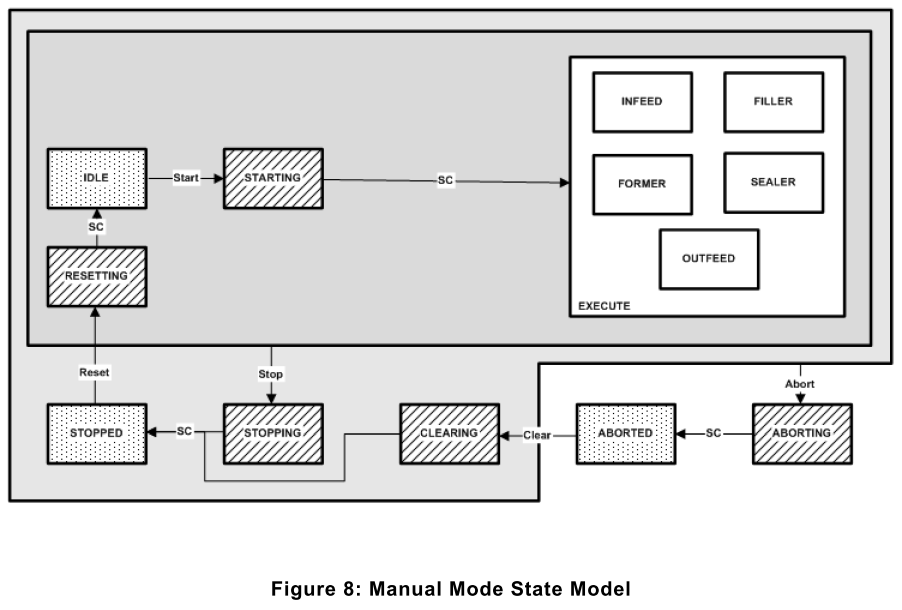
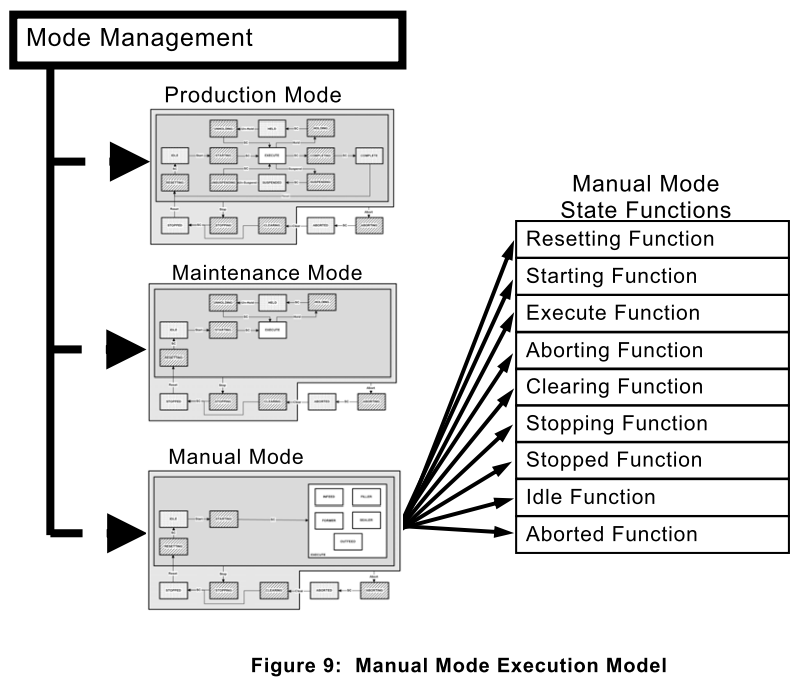
用户模式(User Mode)
Any unit control mode can be defined which provides a required function for the machine. The unit control mode provides for suitably authorized personnel operating the machine under pushbutton control, or for a remote system operating the machine as part of an integrated work center. This report recommends the approach in which all unit control modes are based on a fixed set of enumerated machine states. The “name” of the state(s) may be customized to provide the operator with an intuitive or descriptive name for the state(s), but the function of the state(s) is consistent with and a subset of the general definition of the base state model.
可以定义为机器提供所需功能的任何单元控制模式。单元控制模式允许适当授权的人员在按钮控制下操作机器,或作为集成工作中心的一部分操作机器的远程系统。该报告推荐了所有单元控制模式都基于一组固定的枚举机器状态的方法。可以自定义状态的“名称”以向操作员提供状态的直观或描述性名称,但状态的功能与通用定义的子集一致基态模型。
Below is a depiction of the Weihenstephan standard harmonized to the Base State model in this report. In this User Mode example the EXECUTE state is renamed the OPERATING state to be consistent with the terminology used in the Weihenstephan model. As can be seen the Base State model included states that were collapsed to be consistent with the Weihenstephan standard. The state commands are not defined as causing individual or undefined states; they are commands to implementation logic that describes the corresponding state transitions. There may be multiple conditions that cause a state transition but they do not cause “unique” machine states, they cause implementation specifics within the given framework of given states.
下面是与本报告中的基本状态模型协调的 Weihenstephan 标准的描述。在这个用户模式示例中,EXECUTE 状态被重命名为 OPERATING 状态以与 Weihenstephan 模型中使用的术语一致。可以看出,基本状态模型包括折叠为与 Weihenstephan 标准一致的状态。状态命令未定义为导致单独或未定义的状态;它们是对描述相应状态转换的实现逻辑的命令。可能有多种条件导致状态转换,但它们不会导致“唯一”机器状态,它们会导致给定状态的给定框架内的实现细节
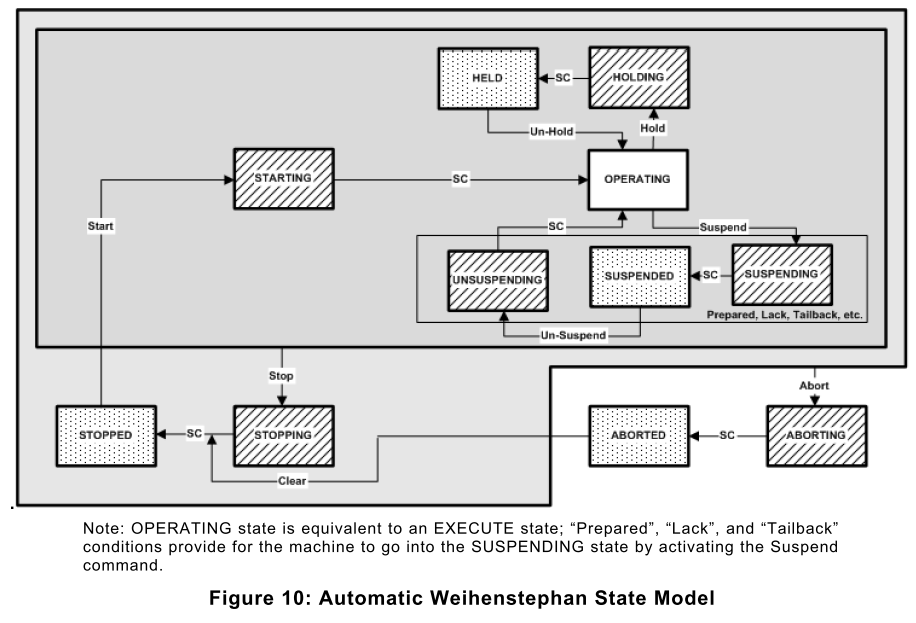
本文作者: Jacob Chen
版权声明: 本博客所有文章除特别声明外,均采用 BY-SA 许可协议。转载请注明出处!
版权声明: 本文为 InfoQ 作者【陈的错题集】的原创文章。
原文链接:【http://xie.infoq.cn/article/8d9798b7758a212cdcc3a649e】。
本文遵守【CC BY-SA】协议,转载请保留原文出处及本版权声明。












评论